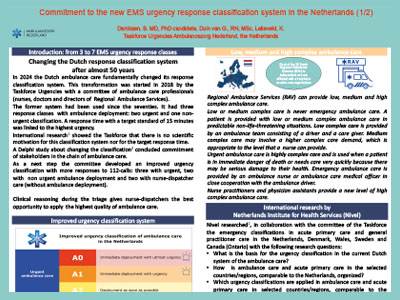ABSTRACTS
Commitment to the New EMS Urgency System in the Netherlands!Author: Trudie van Duin, Bert Dercksen, and Karin Lelievel | | Associate Authors:
In 2024, after almost 50 years, the emergency classification system for Dutch ambulance care changed from three to seven responses. This change was initiated in 2018 by Taskforce Urgency, a committee of ambulance care nurses and ambulance care doctors. The old system, which had been in use since the 1970s, had three urgencies with ambulance deployment: two urgent classifications and one nonurgent classification. A response time with a target standard of 15 minutes was linked to the highest urgency. The taskforce determined that the research did not justify this standard. Beginning in 2019, directors of ambulance services also joined the taskforce. As a next step, an improved urgency classification was developed by the taskforce. This new classification has seven emergencies. Medical reasoning during triage provides the best opportunity to apply good care. Triage of the 1-1-2 calls led to a proposal that responses could range from deploying a high-complex ambulance unit to the patient to the nurse-dispatcher completing the call through a telephonic transfer to a chain-of-care partner or with self-care advice to the patient. The taskforce advised the national association of directors of ambulance care services, Ambulancezorg Nederland, to introduce the improved urgency classification system. The advice was accepted and became reality in 2024. The implementation of the improved urgency classification started in 2023, with the preparation of operationalization at all dispatch centers and ambulance services throughout the country. All stakeholders, from patients and EMS associations to the Ministry of Health Welfare and Sport, were involved in the implementation to ensure that we could really improve the quality of ambulance care. The results have been great. We are very pleased to share them with you at EMS Las Vegas 2024.
|

